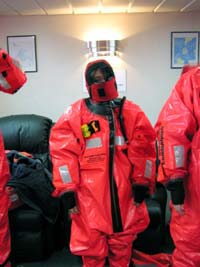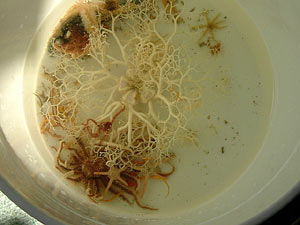| • Home |
| • Questions |
| • Participants |
| • Background Information |
Our “Liberty” had ended at 10am on Tuesday, November 23rd, with a planned noon departure. However, between Customs agents signing us off and equipment glitches (science, not ship!), we left closer to 2pm. Seeing the gangplank lifted by crane and eventually hauled off on the back of a truck made the leaving ever so permanent!

| 1 | 2 | 3 | 4 | 5 | 6 | |
| 7 | 8 | 9 | 10 | 11 | 12 | 13 |
| 14 | 15 | 16 | 17 | 18 | 19 | 20 |
| 21 | 22 | 23 | 24 | 25 | 26 | 27 |
| 28 | 29 | 30 |
| 1 | 2 | 3 | 4 | |||
| 5 | 6 | 7 | 8 | 9 | 10 | 11 |
| 12 | 13 | 14 | 15 | 16 | 17 | 18 |
| 19 | 20 | 21 | 22 | 23 | 24 | 25 |
| 26 | 27 | 28 | 29 | 30 | 31 |
Shortly into our travels, “muster” was called to hold a Sea Safety Review. We brought our life jackets and Survival Suits from our bunk rooms to the main lounge, and proceeded to try them on. We were all challenged to pull on these all-in-one rubber-cuffed and boots-built-in giant orange Gumby suits! It gave a whole new meaning to “one size fits all” as we looked quite ridiculous, but we all knew that these suits could make the difference between life and death should an accident occur that required wearing them. We were also oriented to the location and use of lifeboats. These looked more like “pods” with their egg-shaped construction, and an entryway that was just a small watertight hatch.
A marine pilot must navigate ships in and out of
port, and one actually drove the ship to a point near the end of the
Straits of Magellan before turning it over to the LMG Captain. Around 9pm,
a Pilot boat came out to our ship, picked up the Pilot, and sent us on our
way. There was a pretty sunset around that time, and even more spectacular
was a light array on the eastern horizon that seemed to radiate up to the
clouds in a wide "V" band. This place is like none other.
0630 November 24, 2004 Nature Takes Over and the Real
Science Begins
Lat/Long: N053° 07.845 W067°
23.607
Air temp: 7.8degrees C
Water temp: 6degrees C
Water
depth: 77 meters
Wind speed: 30-35mph (with gusts to 50 at about 6 a.m.!)
Albatross glide over the boiling sea with the grace and ease of a glider plane, depending almost wholly on the wind’s play off the waves. Their tapered wings, sometimes measuring 10 feet tip to tip, barely move, and I haven’t yet seen one resting on the water.
1st plankton tow of the cruise was taken around 7am in 8-foot seas! (Doesn't sound like much, but that, my friends, means a 16-foot trough and a rocky ride!) I could hear a bridge-to-deck radio conversation regarding what was going on on deck and the concern for safety of personnel was impressive. The plankton net was let out on 50 meters of wire, which means it went about 30 meters deep while the ship cruised very slowly. The net brought back a greenish-brown slurry, which means, dun-dun-daaaaahn, phytoplankton (plants)!! We want zooplankton (critters) for our study, and so the challenge began. The lab became immediately active with people looking through the mucky samples under microscopes. Success! There were a few lovely specimens of the critters we needed, and they were carefully pulled from the petri dishes using small pipettes, and put into chilled salt water for later identification and “pickling”.
The 2nd tow, this time to scrape the ocean bottom (benthic), occurred around noon. Think of it the bottom of cold Antarctic waters doesn't seem like a very inviting place to live, right? Well, I was amazed at the array of sealife specimens that came up with this net! The sorting of 4 buckets of samples in the lab turned up sea cucumbers, keyhole limpets and many sea anemones with long, thick tentacles among them, and starfish by the dozens! Most of these represented an array of brittle stars, and a couple of delicate white basket stars were outstanding. Many different worms were identified, such as “featherduster” worms, and also tiny purple clams, live sponges, and one tiny (about 2 inches long) cuttlefish. This process of tow, sorting and documenting alone took about 4 hours.
The tow schedule is what is driving the cruise at present, but there will be time to allow the salp (a type of jellyfish) group to do some SCUBA dive sampling along the way, weather permitting. It is hoped that the first of these will be tonight (not in the dark - it stays light until 10:30pm!!) as the seas have calmed some.

I expect tomorrow we will acknowledge Thanksgiving in some way, still following the tow schedule as we prepare to cross the sometimes-dreaded Drake Passage to the actual Antarctic continent.
Dinner Menu (shipboard, 11/24): |
|
TBD |